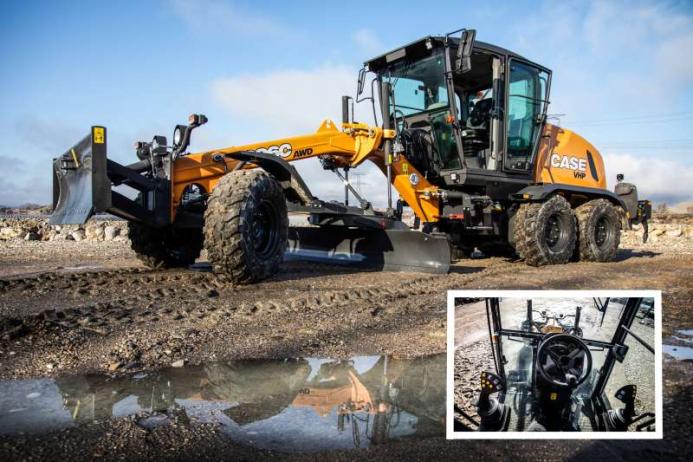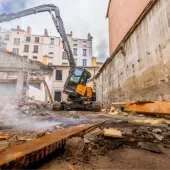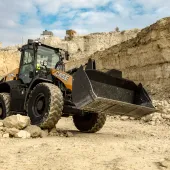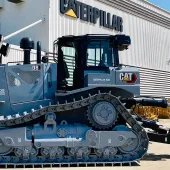New electro-hydraulic joysticks for CASE C-Series graders
Joystick levers deliver improved moldboard control along with range of steering upgrades
CASE Construction Equipment are launching new joystick levers for reduced effort and high precision on their 836C and 856C motor-graders. The electro-hydraulic joysticks are built into multi-adjustable armrests on each side of the operator’s seat.
Each joystick is equipped with multiple roller switches and push buttons, to control the working hydraulic and steering functions. In addition, the redesigned side console now contains additional switches that allow adjustments to the system as per the operator’s needs.
The new joystick steering allows the operator to steer the machine using the left-hand joystick. All steering commands, including turning the front wheels, moving the frame articulation and setting the wheel lean are available through the joystick.
In addition, a new RTC function allows the operator to return all steering commands back to the centred position by pushing a dedicated button. This allows the operator to control the machine without having to take their hands off the joystick levers, reducing effort and increasing productivity.
Combined Steering brings together the various steering commands into one control function. Once activated, front wheel steering, frame articulation and wheel lean work together as the operator turns the steering wheel or moves the joystick.
Additionally, with activated TwinLift, operators have the possibility to move both lift cylinders by using just the right-hand joystick. TwinLift makes it easier for the operator to correct the moldboard position without having to work both joysticks. This feature also assists the operator when grading a wider slope, as he or she can simply lift the moldboard with one joystick to reposition the machine for the next pass.
The CASE C-Series graders are powered by the latest 6.7-litre, six-cylinder FPT diesel engines. Using Hi-eSCR2 technology, they feature a maintenance-free diesel oxidation catalyst (DOC) and selective catalytic reduction on filter (SCRoF) exhaust after-treatment system to comply with the European Stage V emissions standard.
The engines are application-engineered specifically to work in a grader operation, where fast torque response is required to maintain high productivity levels. A Dual Power system offers increased engine output from fourth to sixth gear.
In the case of the 836C and 836C AWD models, the engine develops 102kW (138hp) in first to third gears, shifting to 115kW (156hp) in fourth to sixth ratio. For the larger 856C and 856C AWD graders, the engine develops 129kW (173hp) in first to third, rising to 142kW (190hp) in fourth to sixth gears.
The power is transmitted through an Ergopower powershift transmission with six forward and three reverse gears. Automatic gear shifting optimizes machine performance, leaving the operator free to concentrate on moldboard and blade work. A no-stall torque converter and 100% automatic differential lock ensures maximum traction in all operating conditions.
All-wheel-drive models also feature a Creep mode, allowing the operator to set the forward speed almost independently of engine rev/min. This makes the grader suitable for compaction work, reducing the overall fleet of machines required on site, increasing efficiency and cutting cost for the customer.
The CASE moldboard design maximizes controllability, with a low-friction, roller-mounted encapsulated slewing ring delivering jolt-free rotation torque. This moldboard design results in fewer greasing points, which reduces maintenance time and eliminates the need for periodic replacement of wear inserts – reducing the costs for the customer.
An A-shape frame virtually eliminates lateral stress in off-set positioning and the central saddle can be hydraulically set in five different positions. The operator can rotate the blade more than 90° to each side without any mechanical interference. An infinitely variable radius blade reduces traction effort and improves material roll in finishing operations.
The machines feature a rear-mounted, low-profile, ROPS/FOPS cab with heated and air-suspended seat for best-in-class levels of operator comfort and visibility. Wide, tinted glass provides an excellent view around the machine, with a full view of the mouldboard for the operator. A rear-view camera provides increased safety when reversing.
To further boost the productivity, profitability and uptime of the revised 836C and 856C, CASE also offer a range of optional connected and non-connected after-sales services such as CASE SiteConnect, which enhances telemetry data used by CASE’s Uptime Centre team to provide dealers with alerts based on machine performance and allow fast corrective action to be taken, boosting uptime.
Customers also benefit from greater peace of mind with CASE Care, CASE Protect and CASE Fluid Analysis. CASE Care is a standard planned maintenance programme with genuine parts and lubricants, CASE Protect is an extended warranty programme and CASE Fluid Analysis aims to prevent major failures, optimizing asset reliability and extending operating lifetime.










